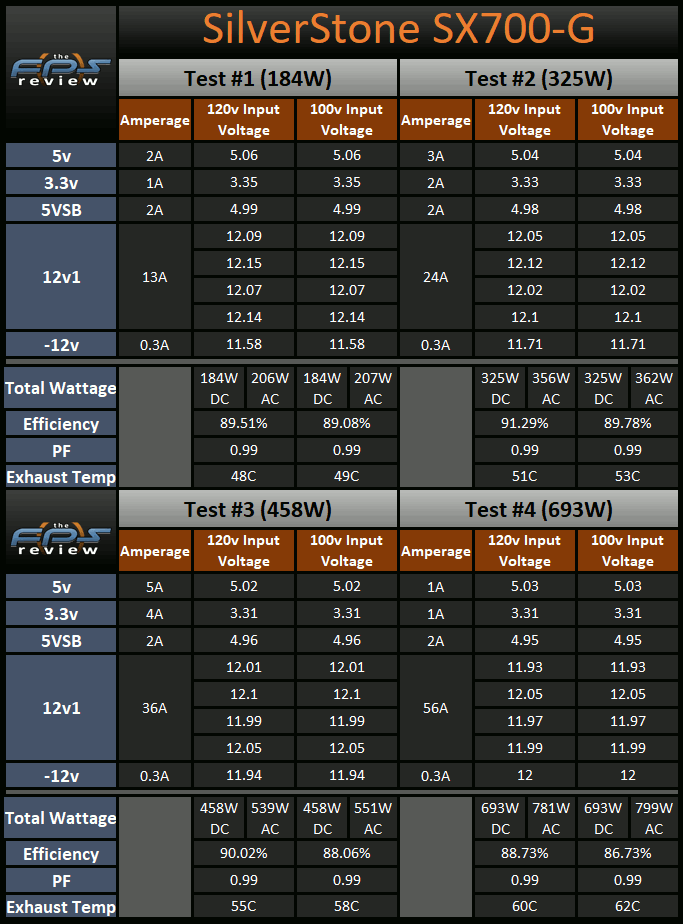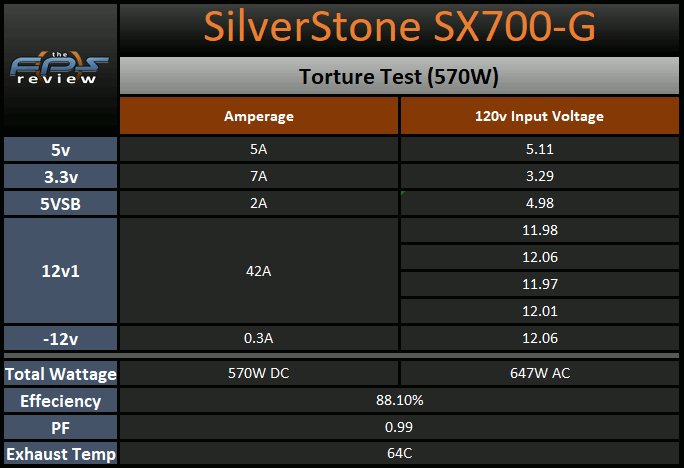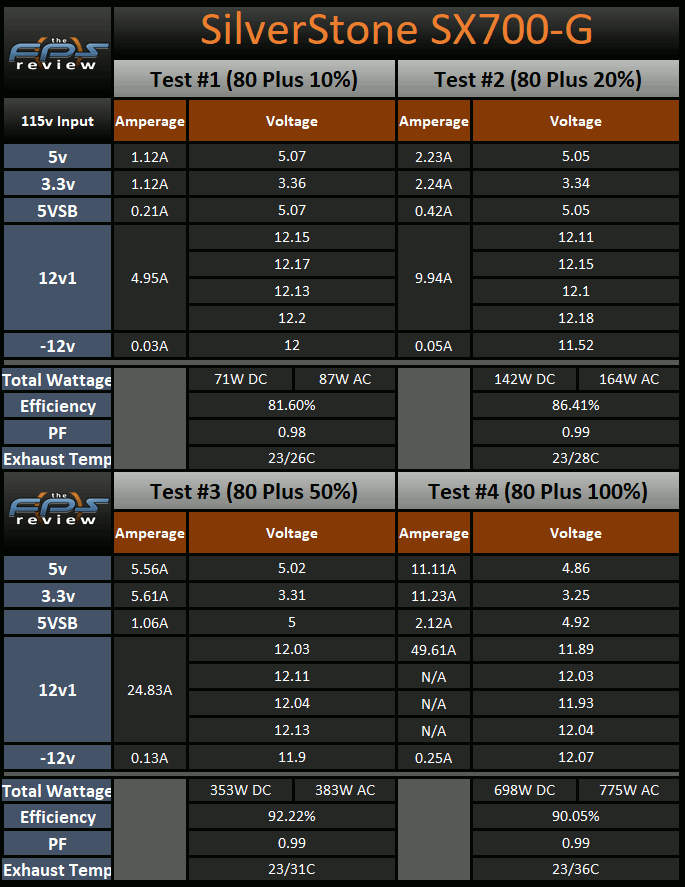Load Testing
For those of you that are curious as to some of the reasoning and equipment behind our PSU testing program here at TheFPSReview, we have put together an introduction for you. This program is based on what the author developed at [H]ardOCP and utilizes the equipment bequeathed to the author by Kyle Bennett. The testing we are conducting today is exactly as described in that document and start with our 120v, 100v, Torture, and 80 Plus Tests.
120v and 100v Load Testing Results

Test #1 is equal to approximately 25% of the rated capacity of the SilverStone SX700-G at 45c. This makes Test #1 equal to 184W by loading the 12v rail to 13a, the 5v rail to 2a, the 3.3v rail to 1a, the +5vsb to 2a, and the -12v to 0.3a. The results of Test #1 show the main positive DC output rails starting above nominal. The efficiency for this unit is starting off in very good shape at a value of 89.51% at 120v AC input and 89.08% at 100v AC input. We see the exhaust temperature is 48C at 120v AC input and 49C at 100V AC input.
Test #2 is equal to approximately 50% of the rated capacity of the SilverStone SX700-G at 45c. This makes Test #2 equal to 325W by loading the 12v rail to 24a, the 5v rail to 3a, the 3.3v rail to 2a, the +5vsb to 2a, and the -12v to 0.3a. Test #2 sees mixed results in DC output voltages relative to what we saw with Test #1. The largest changes are up to a 0.05v decrease on the 12v rail and a 0.02v drop on the 5v and 3.3v rails. The efficiency has moved up to 91.29% at 120v AC input and 89.78% at 100v AC input. We see an exhaust temperature of 51C at 120v AC input and 53C at 100V AC input.
Test #3 is equal to approximately 75% of the rated capacity of SilverStone SX700-G at 45c. This makes Test #3 equal to 458W by loading the 12v rail to 36a, the 5v rail to 5a, the 3.3v rail to 4a, the +5vsb to 2a, and the -12v to 0.3a. Test #3 sees the 5v and 3.3v rails have dropped by 0.02v. The 12v rail has decreased by up to 0.05v. The efficiency in Test #3 moves down to 90.02% at 120v AC input and 88.06% at 100v AC input. We see an exhaust temperature of 55C at 120v AC input and 58C at 100V AC input.
Test #4 is equal to approximately 100% of the rated capacity of the SilverStone SX700-G at 45c. This makes Test #4 equal to 693W by loading the 12v rail to 56a, the 5v rail to 1a, the 3.3v rail to 1a, the +5vsb to 2a, and the -12v to 0.3a. In the final regular test, we see the 12v rail down by up to 0.08v. The minor rails, however, see no change (3.3v) or increase by 0.01v (5v). The efficiency has dropped as we see it come in at 88.73% at 120v AC input and 86.73% at 100v AC input. We see an exhaust temperature of 60C at 120v AC input and 62C at 100V AC input.
Torture Test

The Torture Test is equal to approximately 80% of the rated capacity of the SilverStone SX700-G at 45C. This makes the Torture Test equal to 570W by loading the 12v rail to 42a, the 5v rail to 7a, the 3.3v rail to 5a, the +5vsb to 2a, and the -12v to 0.3a. At the end of the Torture Test, the SX700-G is still doing well. The DC output voltages are generally in line with what we have been seeing in the 120v load tests. The efficiency is very good as we see a value of 88.10% and the exhaust temperature is 64C.
80 Plus Load Testing Results

As we see here, the SX700-G posts efficiency values of 86.41%-92.22%-90.05% using 80 Plus’ load testing parameters. This puts the unit right under the 80 Plus Gold standard in the 20% load test by 0.59%. However, we do use different equipment than 80 Plus for our testing and there is always a bit of component variation.
Load Testing Summary
Today, the SilverStone SX700-G did a very good job in our initial load testing. When we look at the voltage regulation, we see that the SX700-G had peak changes of 0.16v on the 12v rail, 0.04v on the 5v rail, and 0.04v on the 3.3v rail. These absolute values are easily in the specification and this unit is mixed in relation to the only other SFX unit we have reviewed (the FSP Dagger 600W). However, that unit is 100W smaller in capacity, so it is not directly comparable. These very good results extend to the efficiency as it ranged from 88.73% to 91.29% efficient at 120v AC input and 86.73% to 89.78% efficient at 100v AC input. This unit also did well in the 80 Plus efficiency test, but the values posted did miss the 80Plus Gold level in one instance by less than 1%. Lastly, the exhaust temperature peaked at 60C at 120v AC input, 62C at 100v AC input, and 64C during the Torture Test. With very good starting results in today’s testing, let’s move on to the Transient Load Tests.
